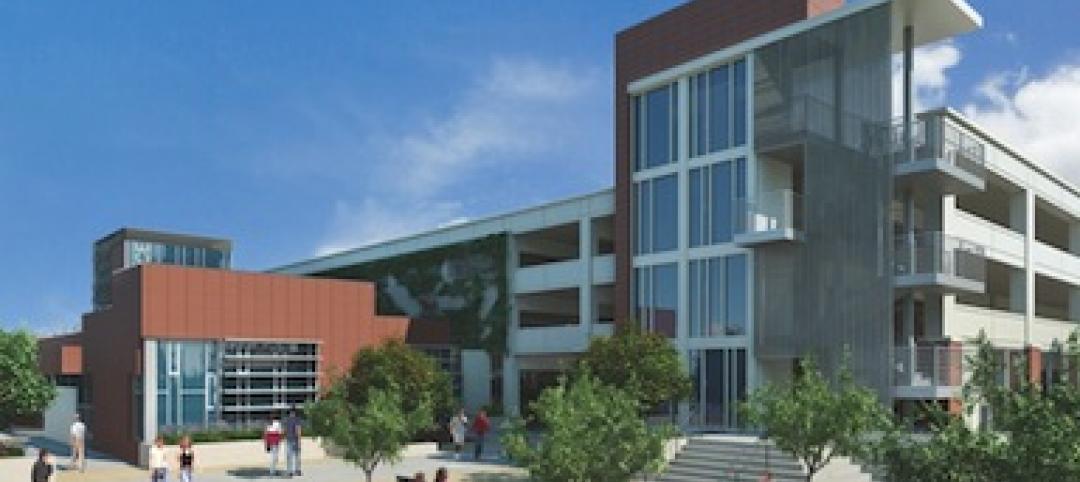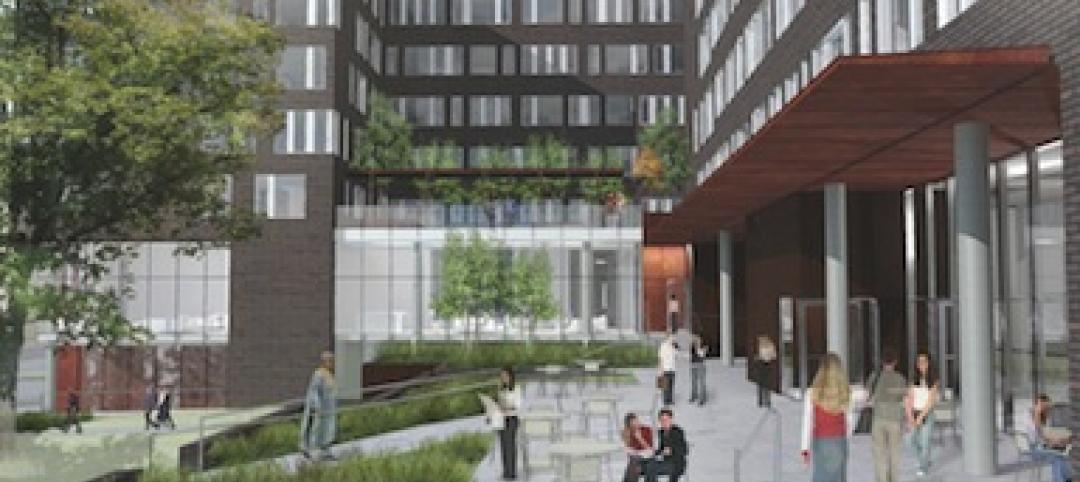While exposed ceilings in office interiors lend a spacious, open feel, this trendy architectural feature has created a new challenge: finding a viable return air path. Plenum ceilings use the area between the dropped ceiling and the floor slab above as a return air path, but when these dropped ceilings are removed, the plenum area is reduced and can restrict the flow of return air.
Since air will always take the path of least resistance, removing all or part of the dropped ceiling and reducing the plenum area can create unique pressure and return airflow patterns, which can vary on a daily, weekly, and seasonal basis, and are usually at their worst when the air handling system is economizer mode (taking in larger quantities of outside air).
Fortunately, with some sound engineering directive, it is often possible to preserve the exposed ceiling while promoting desirable return airflow patterns. Boiled down into five guiding principles, the following can be successfully applied to evaluate and often overcome the exposed ceiling challenge.
1. Better to oversize, not undersize, return air transfer openings.
While architects generally want return air openings to be as small as possible from an aesthetic point of view, engineers strongly recommend generously sizing them in order to encourage the air to properly flow through. Because air will take the path of least resistance to find its way back to the central return air duct and then to the air handling unit, if these openings are undersized, air may flow elsewhere.
One of the most common problems occurs when entry doors to a space are opened and air rushes through these doors. In severe conditions, the doors may even stay partially open due to the strong airflow. A good rule of thumb is to size return air transfer openings so that the air flows through at a low velocity of roughly 250 feet per minute.
2. Select areas of dropped ceilings are often necessary.
In addition to the potentially undesirable aesthetics associated with larger return air openings, exposed ceilings can pose significant acoustical challenges as well. Whether it’s a fan-powered box, duct leakage from improperly sealed ductwork or the sound of air traveling back to the main return, large, open ceilings provide no barrier to attenuate sound.
One potential solution could be dropping in a few architectural clouds, particularly in places where the main return air openings are located (typically near building “core” areas – i.e. elevator banks). For spaces that are particularly challenged acoustically, add sides on the clouds to create a more effective acoustical buffer while still preserving the open plenum look and hiding unsightly mechanical equipment.
3. Avoid returning air through adjacent tenant spaces.
In some buildings with dropped ceilings, return air was designed to run above multiple tenant spaces to find its way back to the central return opening. However, when two tenants with open ceilings are located next to one another, running return air from one tenant space through another is not only undesirable (your neighbor won’t appreciate the smell of your burnt popcorn), but in all likelihood does not meet local code requirements either.
In order to mitigate this, the engineering team should take a holistic look at the building design to figure out exactly how the air is flowing so that a proper return air path can be created for all tenant spaces.
4. Carefully survey the core area ceilings to identify ductwork or other items impeding the free flow of re-turn air.
While generously sizing the return plenum air opening can be an effective way to support optimal air-flow, if the core space is packed with ductwork and/or piping, and thus reducing the area of the return air path, it can create insurmountable challenges. Even if return air openings to the plenum are generously sized, a congested return air plenum will restrict airflow and may still result in undesirable airflow patterns as noted in Item 1.
McGuire was brought in to help with corrections on a recent project: a new tenant occupying two floors inside a Midwest office building added a stairwell to connect their floors. The upper floor’s return air plenum was very congested, which had never been an issue until the new stair was added. The stairwell introduced a new path for the air to flow, creating significant draft issues in the lower floor’s reception area.
In cases such as these, creative engineering must be employed to provide another more appropriate path for the airflow.
5. Every building is different and main air system imbalance or congested corridor ceilings may be difficult or impossible to overcome.
Yet another potential difficulty with exposed ceilings comes into play when a high percentage of outside air is desired for natural ventilation. For example, on a 55°F to 60°F day, a building’s air handling units may run in economizer mode to bring in larger amounts of outside air for “free” cooling. Of course, this same air needs to be returned and exhausted. If an adequate return air path isn’t properly designed—perhaps due to congested ceilings or inadequate transfer openings – the return air problems can often be exacerbated when the building systems are in economizer mode. In such a situation, the building may decide to limit the percentage of outside air intake. While the optimal solution may be to significantly change the layout and re-engineer the space, such an approach may be cost prohibitive.
Careful Consideration
When moving into an existing building and redesigning your space with an open plenum, all HVAC idiosyncrasies must be carefully evaluated. While airflow in an existing tenant space with closed ceilings may be working just fine, once the ceiling is opened up, issues can arise. If any significant issues with regards to the main building air system are discovered, an open ceiling may simply not work, unless the building owner is willing to make the required changes to support a proper return air flow design.
When considering an exposed ceiling for a tenant build-out, it’s important to confer with the facility manager about air patterns, in addition to speaking with other tenants in the building who may have exposed ceilings to learn more about how the air is flowing through those particular spaces.
Armed with this information, the building team can better determine exactly how to design the desired open ceiling space and air plenum to support the architect’s plan, both aesthetically and functionally – maintaining optimal comfort for all occupants.
About the Author
Bill Stangeland is President and Partner with McGuire Engineers. He has more than 30 years of experience in HVAC and plumbing systems design. He is responsible for overall quality control of the firm's business, fostering client satisfaction, and the mentoring and development of new and existing staff. Stangeland's extensive experience encompasses commercial projects, branch banks, churches, auditoriums, medical office buildings, and out-patient surgical suites. He maintains strong client relationships by delivering successful projects that meet each client's unique goals and needs.
Related Stories
| Sep 21, 2010
New BOMA-Kingsley Report Shows Compression in Utilities and Total Operating Expenses
A new report from the Building Owners and Managers Association (BOMA) International and Kingsley Associates shows that property professionals are trimming building operating expenses to stay competitive in today’s challenging marketplace. The report, which analyzes data from BOMA International’s 2010 Experience Exchange Report® (EER), revealed a $0.09 (1.1 percent) decrease in total operating expenses for U.S. private-sector buildings during 2009.
| Sep 21, 2010
Forecast: Existing buildings to earn 50% of green building certifications
A new report from Pike Research forecasts that by 2020, nearly half the green building certifications will be for existing buildings—accounting for 25 billion sf. The study, “Green Building Certification Programs,” analyzed current market and regulatory conditions related to green building certification programs, and found that green building remain robust during the recession and that certifications for existing buildings are an increasing area of focus.
| Sep 21, 2010
Middough Inc. Celebrates its 60th Anniversary
Middough Inc., a top ranking U.S. architectural, engineering and management services company, announces the celebration of its 60th anniversary, says President and CEO, Ronald R. Ledin, PE.
| Sep 16, 2010
Gehry’s Santa Monica Place gets a wave of changes
Omniplan, in association with Jerde Partnership, created an updated design for Santa Monica Place, a shopping mall designed by Frank Gehry in 1980.
| Sep 16, 2010
Green recreation/wellness center targets physical, environmental health
The 151,000-sf recreation and wellness center at California State University’s Sacramento campus, called the WELL (for “wellness, education, leisure, lifestyle”), has a fitness center, café, indoor track, gymnasium, racquetball courts, educational and counseling space, the largest rock climbing wall in the CSU system.
| Sep 13, 2010
Community college police, parking structure targets LEED Platinum
The San Diego Community College District's $1.555 billion construction program continues with groundbreaking for a 6,000-sf police substation and an 828-space, four-story parking structure at San Diego Miramar College.
| Sep 13, 2010
Campus housing fosters community connection
A 600,000-sf complex on the University of Washington's Seattle campus will include four residence halls for 1,650 students and a 100-seat cafe, 8,000-sf grocery store, and conference center with 200-seat auditorium for both student and community use.










